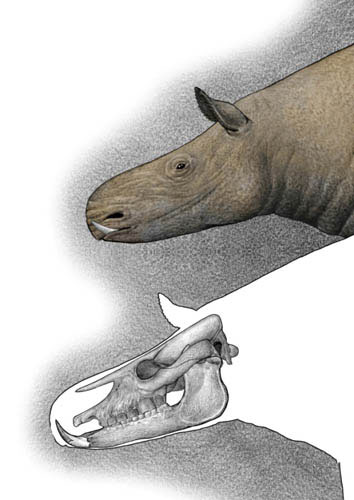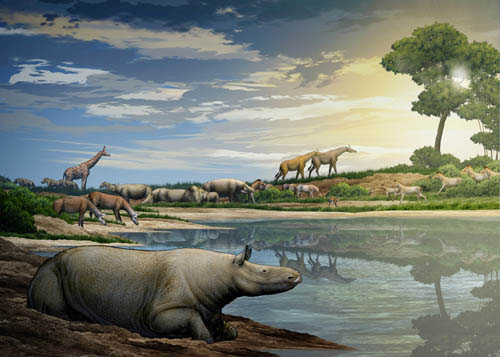Both sexes of Chilotherium have no horns. The snout of the mandible is strongly expanded laterally and has two huge tusks with sharp blades. The upper incisors have completely degenerated and disappeared. They flourished in Eurasia during the late Miocene. . Since the establishment of a new genus of Rhinoceros by Linston (1924), a total of 13 new species of this genus have been described, and 19 other genera and species have been revised and classified into this genus. However, with the continuous deepening of research work, within this genus, The number of valid species was determined to be 10. Recently, the research team of researcher Deng Tao from the Institute of Vertebrate Paleontology and Paleoanthropology, Chinese Academy of Sciences, established a new species of the genus Rhinoceros based on an adult skull associated with the atlas and an adult mandible from Qingyang, Gansu. Chilotherium licenti sp. nov., and systematically discussed the classification and evolution of Chilotherium licenti fossils. The relevant research results were published in the latest issue with doctoral student Sun Danhui as the first author and researcher Deng Tao as the corresponding author. Issue of Vertebrata PalAsiatica.
Specimens of Sang's Rhinoceros are now preserved in the Beijiang Museum in Tianjin. They were collected by French Jesuit priest Sang Zhihua in Qingyang, Gansu in 1920. There are detailed records in his diary. The species name of the new species is to express gratitude to Mr. Sang Zhihua and as a memorial. In addition to the strong expansion of the mandibular symphysis, the Rhinoceros sangii has a huge i2 with an upturned inner blade, a strong contraction of the prototip, the development of front spines and small spines, and weak anterior apex folds and weak anterior apex ribs. In addition, it also has the characteristics of front spines and small spines developing and connecting to form a mesodon (P2–M2), and the internal and external tooth belts degenerating. The progressive characteristics of the new species show that it belongs to a highly specialized group within the genus Macrorrhinus, and its era belongs to the Baode period, corresponding to MN12–13 in Europe. Based on the comparison of morphological characteristics and phylogenetic analysis, it is inferred that Macrorrhinus sangii from the late Miocene is the most advanced species in the genus Macrorrhinus.
The ancestral form of the giant rhinoceros may have lived in Siwalik, South Asia, during the middle Miocene, and then migrated to China, the Middle East and Europe. In the early part of the late Miocene, the genus Rhinoceros of the hornless rhinoceros tribe began to appear, and then the number of individuals increased extremely, becoming the dominant group in the fauna at that time. It was not only widely distributed in the northwest of China, but also found on the Qinghai-Tibet Plateau. The late Miocene was the largest adaptive radiation period for rhinoceros species in China's geological history. The hornless rhinoceros still dominates the genus and species composition. At least three species of large-lipped rhinoceros are common members of the fauna in mainland China. At the same time, the greater rhinoceros has a vast distribution range throughout Eurasia. With the end of the Miocene, China's rhinoids went from prosperity to decline.
This research was supported by the National Natural Science Foundation of China, the Strategic Priority Cultivation Project of the Chinese Academy of Sciences, and the Key Frontier Science Research Project of the Chinese Academy of Sciences.

Figure 1 Skull of Chilotherium licentisp. nov. (TNP 03978), a new species of Chilotherium licentisp. nov. (TNP 03978) in Qingyang, Gansu, holotype A. Side; B. Back; C. Ventral surface (Photo provided by Sun Danhui)

Figure 2 Chilotherium licentisp. nov. (TNP 00328), a new species of Chilotherium licentisp. (TNP 00328) in Qingyang, Gansu Province. A. Side; B. Occlusal surface (Photo provided by Sun Danhui)

Figure 3 Restored picture of Chilotherium licentisp. nov., a new species of Chilotherium licentisp. nov. (drawing by Chen Yu)

Figure 4 Ecological restoration map of Sang’s great-lipped rhinoceros (drawing by Chen Yu)
animal tags: Chilotherium fossil evolution rhinidae
We created this article in conjunction with AI technology, then made sure it was fact-checked and edited by a Animals Top editor.